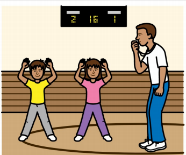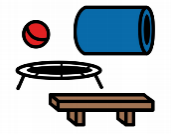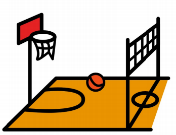Advice for PE Teachers and Coaches (DMD)
Duchenne muscular dystrophy (DMD) is a condition that causes permanent and increasing weakness and disability. For all students, exercise and physical activity are important aspects of remaining fit and healthy. For students with DMD, exercising can be difficult due to muscle weakness and there are precautions that need to be taken to ensure that exercise is safe, effective and enjoyable.
What are the benefits of exercise?
The benefits of exercise and physical activity include weight management, improved heart health, stronger bones and improved sense of well-being. Inactivity leads to muscle weakness, pain, reduced flexibility and function. All of which are factors already experienced by your student with DMD. Engagement in physical activity and exercise needs to be encouraged and supported even when your student’s strength and abilities begin to deteriorate.
What are the principles of exercise in DMD?
Each child with DMD is different and factors like age and their disease stage have a big effect on their function. General principles include:
Intensity:
- Low-moderate intensity aerobic exercise is considered safe and beneficial (ie. the student should be able to talk while exercising but may be a bit red and puffed during the activity).
Stretches:
- Stretching is a big part of a student with DMD's daily disease management plan.
- Warm-up stretches are particularly beneficial to students with DMD whose muscles are stiff and tight.
- An added benefit of modelling stretching with the whole class through warm up exercises, is that you normalise muscle stretching for kids with DMD.
- Your student’s community physiotherapist can provide advice on which stretches are most useful and can help to individualise a program.
Safety:
- Students with DMD are at greater risk of muscle damage than their peers.
- It is important that a student with DMD avoids high-impact, high resistance or eccentric exercise to the point of exhaustion.
- Eccentric exercise: describes working the muscles hard while they are lengthening. Examples of eccentric activities include weightlifting, vigorous trampolining and squats or step-downs.
- If your student experiences delayed-onset muscle soreness (ie. that feeling of sore muscles the day after exercise) that is a sign they have done too much.
Fatigue:
- Respect fatigue.
- If a student with DMD says they are tired or looks like they are struggling with an activity, ensure they are allowed to rest and recover.
Falls:
- Students with DMD are more likely to hurt themselves and are more likely to sustain bone fractures if they fall.
- Consider your activity set-up to minimise the risk of falling and support your student as needed to stay safe.
Participation:
- Encourage students with DMD to have a go at anything that is safe to do so.
- Your student’s community therapy team can support you in problem-solving to maximise their participation.
Skill development:
- Promote exercise and physical activity that helps to develop other motor skills such as balance and coordination.
How to promote inclusion? 'TREE' for inclusive coaching
It starts with change:
T - Change the teaching or coaching style:

- Use visual aids and demonstration. You may need to use physical assistance to demonstrate a movement
- Check for understanding after explanation
- Pair players up to work together
R - Change the rules:

- Allow more bounces in ball games (eg. tennis, cricket, table tennis)
- Allow catching and throwing of the ball or allow the ball to bounce (eg. in volleyball)
- Allow the inclusion of a runner (eg. cricket or baseball)
- Allow an increased length of time (eg. to get to the base/crease/goal)
- Reduce the distance required to run (eg. move bases closer together, allow child to be closer to the goal/target, allow them to serve (in tennis) or bowl (in cricket) from mid court/pitch)
- Provide more chances to score (eg. allow 3 attempts to catch instead of 1, can’t get out first ball in cricket)
- Use a handicap system giving slower runners a head start (eg. in athletics)
E - Change the equipment:

- Use lighter, shorter equipment such as a bat or racket (a strap may to assist with securing it to the hand)
- Use a lighter, larger and/or softer ball to reduce the speed of the ball (eg. low bounce tennis balls travel more slowly)
- Increase the size of the target or goals (eg. shooting a basketball into a tub rather than into the ring)
E - Change the environment:

- Reducing the distance required to run (eg. in athletics)
- Reduce the size of the court
- Lower the goal ring height(eg. in basketball)
- Allow a ‘safe zone’ around your student with DMD that other students are not allowed to enter
Other ideas:
- Engage the student in coaching role, umpiring, keeping stats or writing a sports report for the newsletter
- Consider giving the whole class the opportunity to try wheelchair sports (school incursions are available)
- Focus on ‘personal bests’ eg. time, number of catches, number of goals rather than winning
- Allow a student who uses an electric wheelchair or mobility scooter to compete in their wheeled mobility device (eg. in athletics races)
Based on inclusive coaching information from sportaus.gov.au website
